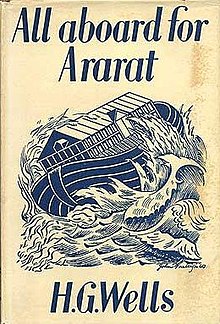
Noah appears as the last of the Antediluvian patriarchs in the traditions of Abrahamic religions. His story appears in the Hebrew Bible, the Quran and Baha'i writings. Noah is referenced in various other books of the Bible, including the New Testament, and in associated deuterocanonical books.

Noah's Ark is the boat in the Genesis flood narrative through which God spares Noah, his family, and examples of all the world's animals from a global deluge. The story in Genesis is based on earlier flood myths originating in Mesopotamia, and is repeated, with variations, in the Quran, where the Ark appears as Safinat Nūḥ and al-fulk. The myth of the global flood that destroys all life begins to appear in the Old Babylonian Empire period. The version closest to the biblical story of Noah, as well as its most likely source, is that of Utnapishtim in the Epic of Gilgamesh. The Book of Genesis was probably composed around the 5th century BCE, although some scholars believe that primeval history, including the flood narrative, may have been composed and added as late as the 3rd century BCE.

Mount Ararat or Masis, also known as Mount Ağrı and Mount Agirî, is a snow-capped and dormant compound volcano in eastern Turkey. It consists of two major volcanic cones: Greater Ararat and Little Ararat. Greater Ararat is the highest peak in Turkey and the Armenian Highland with an elevation of 5,137 m (16,854 ft); Little Ararat's elevation is 3,896 m (12,782 ft). The Ararat massif is about 35 km (22 mi) wide at ground base. The first recorded efforts to reach Ararat's summit were made in the Middle Ages, and Friedrich Parrot, Khachatur Abovian, and four others made the first recorded ascent in 1829.

Noah, also known as Nuh, is recognized in Islam as a prophet and messenger of God. He is one of the Ulu'l azm prophets. Noah's mission was to warn his people, who were plunged in idol worshipping. God charged Noah with the duty of preaching to his people, advising them to abandon idolatry and to worship only God and to live good and pure lives. Although he preached the Message of God with zeal, his people refused to mend their ways, leading to building the Ark and the Deluge, the Great Flood. In Islamic tradition, it is disputed whether the Great Flood was a global or a local one. Noah's preaching and prophethood spanned 950 years according to the Quran, Ahadith and Tafsir.

The Bible...In the Beginning is a 1966 religious epic film produced by Dino De Laurentiis and directed by John Huston. It recounts the first 22 chapters of the Biblical Book of Genesis, covering the stories from The Creation and Adam and Eve to the binding of Isaac.

Searches for Noah's Ark have been reported since antiquity, as ancient scholars sought to affirm the historicity of the Genesis flood narrative by citing accounts of relics recovered from the Ark. With the emergence of biblical archaeology in the 19th century, the potential of a formal search attracted interest in alleged discoveries and hoaxes. By the 1940s, expeditions were being organized to follow up on these apparent leads. This modern search movement has been informally called "arkeology".

Noach, Noiach, Nauach, Nauah, or Noah is the second weekly Torah portion in the annual Jewish cycle of Torah reading. It constitutes Genesis 6:9–11:32. The parashah tells the stories of the Flood and Noah's Ark, of Noah's subsequent drunkenness and cursing of Canaan, and of the Tower of Babel.
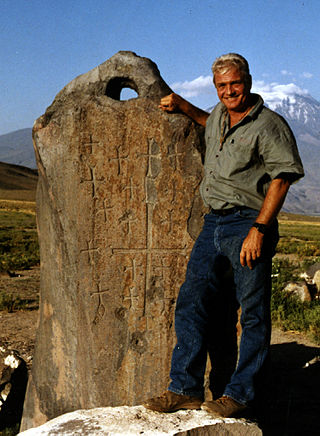
David Franklin Fasold was a United States Merchant Marine officer and salvage expert who is best known for his 1988 book The Ark of Noah, chronicling his early expeditions to the Durupınar Noah's Ark site in eastern Turkey. Repudiating and then changing his views about the site, Fasold was a participant in a suit with Australian geologist and skeptic Ian Plimer against an Australian creationist group. The suit, dubbed the "Monkey Trial II," was a notable case in the debate between science and religion and its role in society.

The Gilgamesh flood myth is a flood myth in the Epic of Gilgamesh. It is one of three Mesopotamian Flood Myths alongside the one including in the Eridu Genesis, and an episode from the Atra-Hasis Epic. Many scholars believe that the flood myth was added to Tablet XI in the "standard version" of the Gilgamesh Epic by an editor who used the flood story from the Epic of Atra-Hasis. A short reference to the flood myth is also present in the much older Sumerian Gilgamesh poems, from which the later Babylonian versions drew much of their inspiration and subject matter.
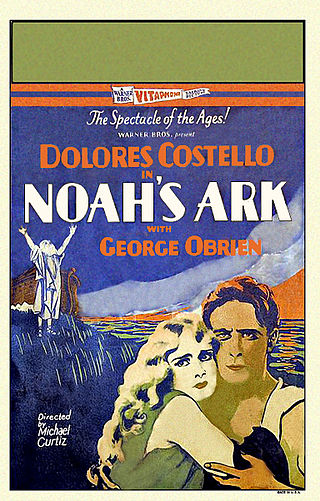
Noah's Ark is a 1928 American part-talkie epic disaster film directed by Michael Curtiz and starring Dolores Costello and George O'Brien. In addition to sequences with audible dialogue or talking sequences, the film features a synchronized musical score and sound effects along with English intertitles. The soundtrack was recorded using the Vitaphone sound-on-disc system. The story is by Darryl F. Zanuck. The film was released by the Warner Bros. studio. Most scenes are silent with a synchronized music score and sound effects, in particular the biblical ones, while some scenes have dialogue.

Allusions in rabbinic literature to the Biblical character Noah, who saved his family and representatives of all the animals from a great flood by constructing an ark, contain various expansions, elaborations and inferences beyond what is presented in the text of the Bible itself.
The Quran contains references to more than fifty people and events also found in the Bible. While the stories told in each book are generally comparable, there are also some notable differences.
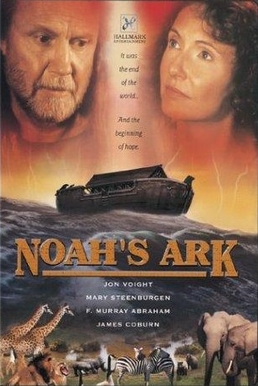
Noah's Ark is a 1999 American-Australian television miniseries directed by John Irvin and starring Jon Voight, Mary Steenburgen, F. Murray Abraham, Carol Kane, Jonathan Cake, Alexis Denisof, Emily Mortimer, Sydney Tamiia Poitier, and James Coburn. The film is a fictional adaptation of Noah's Ark from the Book of Genesis. It was initially televised in the United States, that same year, was also televised in Canada, Germany and Portugal, among other countries.

The Genesis Apocryphon (1Q20), also called the Tales of the Patriarchs or the Apocalypse of Lamech and labeled 1QapGen, is one of the original seven Dead Sea Scrolls discovered in 1946 by Bedouin shepherds in Cave 1 near Qumran, a small settlement in the northwest corner of the Dead Sea. Composed in Aramaic, it consists of four sheets of leather. Furthermore, it is the least well-preserved document of the original seven. The document records a pseudepigraphal conversation between the biblical figure Lamech, son of Methuselah, and his son, Noah, as well as first and third person narratives associated with Abraham. It is one of the nonbiblical texts found at Qumran. A range of compositional dates for the work have been suggested from the 3rd century BC to 1st century AD. Palaeography and Carbon-14 dating were used to identify the age of the documents. It is 13 inches in length and 2.75 inches in width at its widest point in the middle.
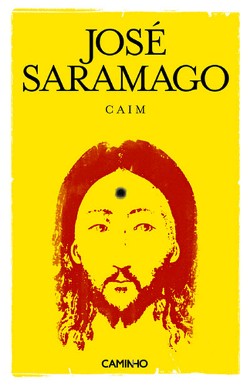
Cain is the last novel by the Nobel Prize-winning Portuguese author José Saramago. The book was first published in 2009. In an earlier novel, The Gospel According to Jesus Christ, Saramago retold the main events of the life of Jesus Christ, as narrated in the New Testament, presenting God as the villain. In Cain, Saramago focuses on the Hebrew Bible.
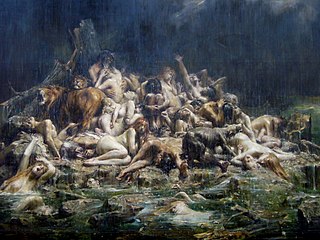
The Genesis flood narrative is a Hebrew flood myth. It tells of God's decision to return the universe to its pre-creation state of watery chaos and remake it through the microcosm of Noah's ark.

Noah is a 2014 American epic biblical drama film directed by Darren Aronofsky, who co-wrote the screenplay with Ari Handel. Inspired by the biblical story of Noah's Ark from the Book of Genesis and the Book of Enoch, it stars Russell Crowe as Noah, along with Jennifer Connelly, Ray Winstone, Emma Watson, Logan Lerman, and Anthony Hopkins.

The Croquet Player is a 1936 novella by H. G. Wells, "a sort of ghost story." It has been called "a short allegory written under the stimulus of the Spanish War."

The Noah's Ark silver coins are Armenian bullion coins issued since 2011. They are available in various sizes with a fine weight between 1⁄4 ounce and 5 kg in silver of 999/1000 fineness. The 1 troy oz. coin has a nominal value of 500 Drams and is legal tender in Armenia. The coin is produced by the Leipziger Edelmetallverarbeitungs GmbH, an affiliated company of Geiger Edelmetalle. The motif of the coin remains constant, similar to other bullion coins such as the Canadian Silver Maple Leaf, the Vienna Philharmonic, and the American Silver Eagle.
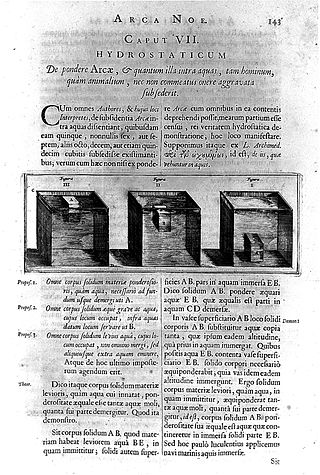
Arca Noë is a book published in 1675 by the Jesuit scholar Athanasius Kircher. It is a study of the biblical story of Noah's Ark, published by the cartographer and bookseller Johannes van Waesbergen in Amsterdam. Kircher's aim in Arca Noë was to reconcile recent discoveries in nature and geography with the text of the Bible. This demonstration of the underlying unity and truth between revelation and science was a fundamental task of Catholic scholarship at the time. Together with its sister volume Turris Babel, Arca Noë presented a complete intellectual project to demonstrate how contemporary science supported the account of the Book of Genesis.
